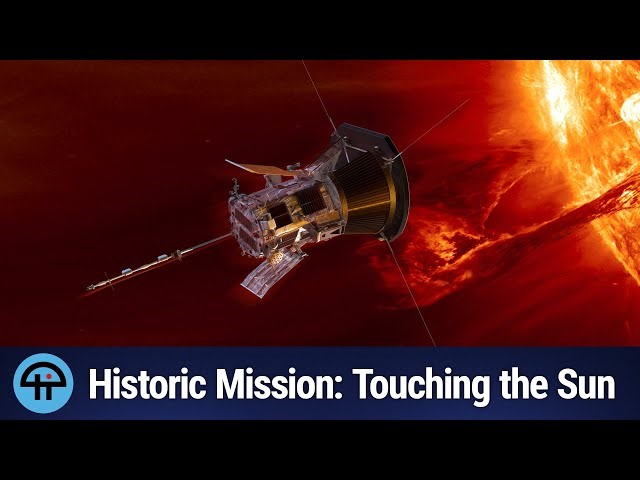Parker Solar Probe: Unraveling the Mysteries of the Sun
Syllabus:
GS-3:
Space Technology , Achievements of Indians in Science & Technology
Focus:
NASA’s Parker Solar Probe made a record-breaking approach to the Sun on March 22, 2025, coming within 6 million km of its surface. This milestone provides new insights into solar wind, magnetic fields, and coronal heating, advancing our understanding of solar phenomena and their impact on Earth.
The Mission to “Touch” the Sun
- Historical Significance and Objective:
- NASA’s Parker Solar Probe, launched in August 2018 aboard a Delta IV rocket from Cape Canaveral, is humanity’s first mission designed to “touch” the Sun.
- The mission aims to gather unprecedented data on the Sun’s outer atmosphere (corona) and understand solar wind and its impact on Earth.
- Record-Breaking Achievements:
- On December 24, 2024, the probe reached within 1 million km of the Sun’s surface—the closest any spacecraft has ever ventured.
- On March 22, 2025, it made another close approach, with a final approach scheduled for June 19, 2025.
- The probe travels at a maximum speed of 692,000 km/hr, covering over 2,000 hours flying through the corona.
Key Facts Related to Parker Solar Probe:About: ● Launched in 2018, the Parker Solar Probe is a car-sized robotic spacecraft named after American solar astrophysicist Eugene Newman Parker. ● It is NASA’s first mission named after a living researcher and aims to explore within 3.8 million miles of the Sun’s corona. ● The probe features an advanced carbon-composite heat shield designed to withstand extreme temperatures. Objectives: ● Approach within 6.5 million kilometers of the Sun to study energy flow and corona heating. ● Investigate the source of solar winds—high-speed streams of charged particles affecting space weather. ● Solve the mystery of why the Sun’s corona is hotter than its surface. ● Analyze the structure and dynamics of plasma and magnetic fields at the solar wind’s origin. ● Explore mechanisms that accelerate and transport energetic particles. About Aditya-L1 Mission: ● India’s solar observatory mission at Lagrange Point L1 enables continuous observation of the Sun’s chromospheric and coronal dynamics. ● Positioned in a halo orbit around L1, approximately 1.5 million km from Earth. ● Equipped with seven payloads to observe the photosphere, chromosphere, and corona using electromagnetic and particle detectors. Understanding Lagrange Points: About: ● Lagrange Points are positions in a two-body gravitational system where a small object remains stable by balancing gravitational forces and centripetal force. Types: ● L1: Lies between the Sun and Earth (1% of Earth-Sun distance); ideal for solar observations. ● L2: Behind Earth from the Sun, suitable for deep space observations without Earth’s shadow. ● L3: Behind the Sun, opposite Earth; enables far-side solar observations. ● L4 & L5: Form stable equilateral triangles with the two large bodies, useful for observational and gravitational studies. |
Studying the Sun: The Importance of Solar Exploration:
The Sun’s Influence on Earth
- Energy Source and Space Weather:
- The Sun is the primary source of energy for Earth’s life forms. Nuclear fusion in its core produces immense energy radiated across the solar system.
- The Sun’s magnetic fields undergo dynamic changes, resulting in solar flares and coronal mass ejections (CMEs)—explosions that emit high-energy particles.
- Impacts of Solar Storms:
- Solar storms caused by CMEs can disrupt:
- Telecommunications and GPS Systems
- Electrical Grids (causing power outages)
- Satellites and Spacecraft Instruments
- Ozone Layer (potential long-term effects)
- Telecommunications and GPS Systems
- Solar storms caused by CMEs can disrupt:
Why Study the Corona?
- Understanding the Solar Corona:
- The corona, the outermost layer of the Sun’s atmosphere, emits charged particles at speeds up to 900 km/s.
- These particles influence space weather and cause geomagnetic storms on Earth.
- Studying the corona helps scientists understand how solar wind and magnetic fields behave, which is crucial for space exploration and satellite safety.
Overcoming Challenges: Parker Solar Probe’s Advanced Technology
The Heat Shield: Protecting the Probe from Extreme Temperatures
- Thermal Protection System (TPS):
- The probe uses an 8-foot-wide, 4.5-inch thick carbon-carbon composite shield that can withstand temperatures up to 1,370°C.
- Built by Johns Hopkins Applied Physics Laboratory, the shield consists of:
- Carbon Composite Foam: Sandwiched between carbon plates
- White Ceramic Paint: Reflects sunlight, preventing absorption
- The shield’s efficiency allows the instruments behind it to operate at a temperature of just 29°C.
- Solar Power and Cooling Mechanism:
- The probe has two solar array sets:
- One in the shield’s shadow powers instruments.
- The other, on the sun-facing side, uses a fluid cooling system to manage heat during close approaches.
- The probe has two solar array sets:
Navigational Challenges and Flight Path Optimization
- Overcoming the Sun’s Gravity:
- The challenge was to slow down the probe enough to avoid crashing into the Sun due to its gravitational pull.
- Initially, the mission considered using Jupiter’s gravity to reduce speed, but this was deemed inefficient.
- Instead, the probe used a series of flybys around Venus and Earth to gradually spiral closer to the Sun.
Scientific Instruments and Groundbreaking Discoveries
Instruments on Board the Parker Solar Probe
- FIELDS: Measures electric and magnetic fields in the Sun’s atmosphere.
- Integrated Science Investigation of the Sun (ISoIS): Observes energetic particles responsible for solar storms.
- Wide-Field Imager for Solar Probe (WISPR): Captures images of the Sun’s corona and solar wind.
- Solar Wind Electrons Alphas and Protons (SWEAP): Measures properties of charged particles in the solar wind.
- Faraday Cup: Analyzes ions and electrons in the solar wind, made from a molybdenum alloy with a melting point of 2,349°C.
Key Discoveries and Scientific Insights
- Dust-Free Zones:
- Contrary to previous beliefs, the solar system is not uniformly dusty. The Parker Solar Probe identified dust-free pockets near the Sun.
- Magnetic Switchbacks:
- Detected magnetic switchbacks—areas where the magnetic field reverses direction abruptly.
- These findings offer insights into the behavior of solar wind and its impact on space weather.
- Alfvén Waves and Corona Heating Mystery:
- The Sun’s surface is 6,000°C, but the corona is over 200 times hotter.
- Parker’s data suggests Alfvén waves—oscillations of ions in the Sun’s plasma, driven by magnetic fields—may be responsible for this phenomenon.
Future Prospects and Conclusion:
The Road Ahead: Ongoing and Future Missions
- The Parker Solar Probe will continue to approach the Sun, gathering more data on solar wind, magnetic fields, and corona dynamics.
- These insights will enhance our understanding of space weather and its effects on Earth.
The Significance of Parker Solar Probe’s Mission
- The mission aims to deepen our understanding of how the Sun works and its impact on the solar system.
- The data will aid in protecting satellites, space missions, and technological infrastructure on Earth.
- The findings also pave the way for future solar missions and improved space weather forecasting.
Conclusion :
The Parker Solar Probe’s mission marks a revolutionary step in solar exploration. Its groundbreaking data will help predict space weather, safeguard satellites, and enhance our understanding of the Sun’s dynamics, ultimately supporting technological advancements and protecting Earth’s critical infrastructure from solar storms.
Source: TH




